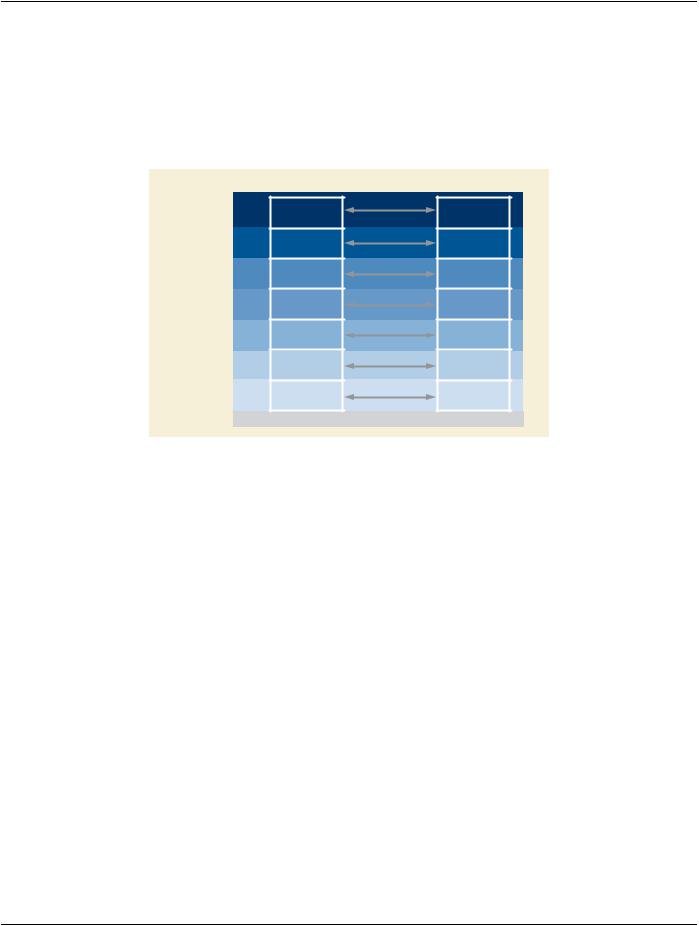
PS-2020a / part08
.pdf
DICOM PS3.8 2020a - Network Communication Support for Message Exchange |
Page 11 |
Foreword
This DICOM Standard was developed according to the procedures of the DICOM Standards Committee.
The DICOM Standard is structured as a multi-part document using the guidelines established in [ISO/IEC Directives, Part 2].
DICOM® is the registered trademark of the National Electrical Manufacturers Association for its standards publications relating to di- gital communications of medical information, all rights reserved.
HL7® and CDA® are the registered trademarks of Health Level Seven International, all rights reserved.
SNOMED®, SNOMED Clinical Terms®, SNOMED CT® are the registered trademarks of the International Health Terminology Standards Development Organisation (IHTSDO), all rights reserved.
LOINC® is the registered trademark of Regenstrief Institute, Inc, all rights reserved.
- Standard -

Page 12 |
DICOM PS3.8 2020a - Network Communication Support for Message Exchange |
- Standard -

DICOM PS3.8 2020a - Network Communication Support for Message Exchange |
Page 13 |
1 Scope and Field of Application
The Communication Protocols specified in this Part of PS3 closely fit the ISO Open Systems Interconnection Basic Reference Model (ISO 7498-1, see Figure 1-1). They relate to the following layers: Physical, Data Link, Network, Transport, Session, Presentation and the Association Control Services (ACSE) of the Application layer. The communication protocols specified by this Part are general purpose communication protocols (TCP/IP) and not specific to this Standard. The other aspects of the Application Layer protocols are addressed in other parts of this Standard as discussed in PS3.1 “PS3.1”.
Layer |
OSI End-System |
Peer Protocol |
OSI End-System |
Application |
|
|
|
Presentation |
|
|
|
Session |
|
|
|
Transport |
|
|
|
Network |
|
|
|
Data Link |
|
|
|
Physical |
|
|
|
Physical Media
Figure 1-1. ISO OSI Basic Reference Model
- Standard -

Page 14 |
DICOM PS3.8 2020a - Network Communication Support for Message Exchange |
- Standard -

DICOM PS3.8 2020a - Network Communication Support for Message Exchange |
Page 15 |
2 Normative References
The following standards contain provisions which, through reference in this text, constitute provisions of this Standard. At the time of publication, the editions indicated were valid. All standards are subject to revision, and parties to agreements based on this Standard are encouraged to investigate the possibilities of applying the most recent editions of the standards indicated below.
2.1 International Standards
[ISO/IEC Directives, Part 2] ISO/IEC. 2016/05. 7.0. Rules for the structure and drafting of International Standards. http://www.iec.ch/ members_experts/refdocs/iec/isoiecdir-2%7Bed7.0%7Den.pdf .
[ISO 7498-1] ISO. 1994. Information Processing Systems - Open Systems Interconnection - Basic Reference Model.
[ISO 7498-3] ISO. 1997. Information Processing Systems - Open Systems Interconnection - Naming and Addressing.
[ISO 8327] ISO. 1996. Information Processing Systems - Open Systems Interconnection - Connection Oriented Session Protocol Specification.
[ISO8649]ISO.1988.Informationprocessingsystems-OpenSystemsInterconnection-ServicedefinitionfortheAssociationControl Service Element (ACSE).
[ISO 8650] ISO. 1987. Information Processing Systems - Open Systems Interconnection - Protocol Specification for the Association Control Service Element.
[ISO/TR 8509] ISO. Information Processing Systems - Open Systems Interconnection - Service Conventions. ISO/TR 8509 has been withdrawn. See ISO/IEC 2382-26:1993 Information technology - Vocabulary - Part 26: Open systems interconnection .
[ISO 8822] ISO. 1988. Information processing systems - Open Systems Interconnection - Connection oriented presentation service definition.
[ISO 8823] ISO. 1988. Information processing systems - Open Systems Interconnection - Connection Oriented Presentation Protocol Specification.
[ISO 8824] ISO. 1990. Information processing systems - Open Systems Interconnection - Specification of Abstract Syntax Notation One (ASN.1).
[ISO 8825] ISO. 1990. Information processing systems - Open Systems Interconnection - Specification of Basic Encoding Rules for Abstract Syntax Notation One (ASN.1).
[ISO/IEC 9545] ISO. 1994. Information processing systems - Open Systems Interconnection - Application Layer Structure.
[ISO/IEC 9834-1] ISO. 2012. Information processing systems - Open Systems Interconnection - Procedures for the operation of OSI Registration Authorities: General procedures and top arcs of the ASN.1 Object Identifier tree.
[ISO/IEC TR 10000-1] ISO. 1998. Information processing systems - Open Systems Interconnection - International Standardized Profiles, Part 1: Taxonomy Framework.
2.2 Other Documents
[NIST SP 500-150] NIST. Stable Implementation Agreements for Open Systems Interconnection Protocols.
[RFC791] IETF. September 1981. Internet Protocol - DARPA Internet Protocol Specification. http://tools.ietf.org/html/rfc791 .
[RFC792] IETF. September 1981. Internet Control Message Protocol - DARPA Internet Program Protocol Specification. http:// tools.ietf.org/html/rfc792 .
[RFC793] IETF. September 1981. Transmission Control Program - DARPA Internet Protocol Specification. http://tools.ietf.org/html/ rfc793 .
[RFC950] IETF. August 1985. Internet Subnetting. http://tools.ietf.org/html/rfc950 .
- Standard -

Page 16 |
DICOM PS3.8 2020a - Network Communication Support for Message Exchange |
[RFC1881] IETF. December 1995. IPv6 Address Allocation Management. http://tools.ietf.org/html/rfc1881 . [RFC2460] IETF. December 1998. Internet Protocol, Version 6 (IPv6) Specification. http://tools.ietf.org/html/rfc2460 .
- Standard -

DICOM PS3.8 2020a - Network Communication Support for Message Exchange |
Page 17 |
3 Definitions
For the purposes of this Standard the following definitions apply.
3.1 Reference Model Definitions
This Part of the Standard is based on the concepts developed in [ISO 7498-1] and makes use of the following terms defined in it:
Application Entity |
See [ISO 7498-1]. |
Application Layer |
See [ISO 7498-1]. |
Application Process |
See [ISO 7498-1]. |
Data Link Layer |
See [ISO 7498-1]. |
Layer Entity |
See [ISO 7498-1]. |
Network Layer |
See [ISO 7498-1]. |
Physical Layer |
See [ISO 7498-1]. |
Presentation Layer |
See [ISO 7498-1]. |
Presentation Service |
See [ISO 7498-1]. |
Protocol |
See [ISO 7498-1]. |
Protocol Data Unit |
See [ISO 7498-1]. |
Service |
See [ISO 7498-1]. |
Service Access Point |
See [ISO 7498-1]. |
Session Layer |
See [ISO 7498-1]. |
Transfer Syntax |
See [ISO 7498-1]. |
Transport Layer |
See [ISO 7498-1]. |
Transport Protocol |
See [ISO 7498-1]. |
Transport Connection |
See [ISO 7498-1]. |
3.2 Naming and Addressing Definitions
This Part of the Standard makes use of the following terms defined in [ISO 7498-3]:
Calling Presentation Address |
See [ISO 7498-3]. |
Called Presentation Address |
See [ISO 7498-3]. |
Presentation Address |
See [ISO 7498-3]. |
Responding Presentation |
See [ISO 7498-3]. |
Address |
|
Called Application Entity Title |
See [ISO 7498-3]. |
Calling Application Entity Title |
See [ISO 7498-3]. |
- Standard -

Page 18 |
DICOM PS3.8 2020a - Network Communication Support for Message Exchange |
3.3 Service Conventions Definitions
This Part of the Standard makes use of the following terms defined in [ISO/TR 8509]:
Service Provider |
See [ISO/TR 8509]. |
Service User |
See [ISO/TR 8509]. |
Confirmed Service |
See [ISO/TR 8509]. |
Non-confirmed Service |
See [ISO/TR 8509]. |
Primitive |
See [ISO/TR 8509]. |
Request (Primitive) |
See [ISO/TR 8509]. |
Indication (Primitive) |
See [ISO/TR 8509]. |
Response (Primitive) |
See [ISO/TR 8509]. |
Confirmation (Primitive) |
See [ISO/TR 8509]. |
3.4 Presentation Service Definitions
This Part of the Standard makes use of the following terms defined in [ISO 8822]:
Abstract Syntax |
See [ISO 8822]. |
Abstract Syntax Name |
See [ISO 8822]. |
Presentation Context |
See [ISO 8822]. |
Presentation Data Values |
See [ISO 8822]. |
Transfer Syntax Name |
See [ISO 8822]. |
3.5 ACSE Service Definitions
This Part of the Standard makes use of the following terms defined in [ISO 8649]:
Association |
See [ISO 8649]. |
Application Context |
See [ISO 8649]. |
Association Control Service |
See [ISO 8649]. |
Element (ACSE) |
|
Association Initiator |
See [ISO 8649]. |
3.6 DICOM Introduction and Overview Definition
This Part of the Standard makes use of the following terms defined in PS3.1:
Message Message.
3.7 DICOM Communication Support Definitions
The following definitions are commonly used in this Part of the Standard:
- Standard -

DICOM PS3.8 2020a - Network Communication Support for Message Exchange |
Page 19 |
|
DICOM Upper Layer Service |
The Upper Layer protocols are related to the Session, Presentation and part of the Application |
|
|
LayeroftheISOreferencemodel.TheseprotocolsprovidetheUpperLayerService.ThisService |
|
|
is a proper subset of the ACSE Service and OSI Presentation Layer Service. |
|
3.8 DICOM Service Class Definitions |
|
|
This Part of the Standard makes use of the following terms defined in PS3.4: |
|
|
Service-Object Pair Instance |
Service-Object Pair Instance (SOP Instance). |
|
(SOP Instance) |
|
|
3.9 DICOM Data Structures and Encoding Definitions |
|
|
This Part of the Standard makes use of the following terms defined in PS3.5: |
|
|
Data Set |
Data Set. |
|
Unique Identifier (UID) |
Unique Identifier (UID). |
|
- Standard -

Page 20 |
DICOM PS3.8 2020a - Network Communication Support for Message Exchange |
- Standard -
